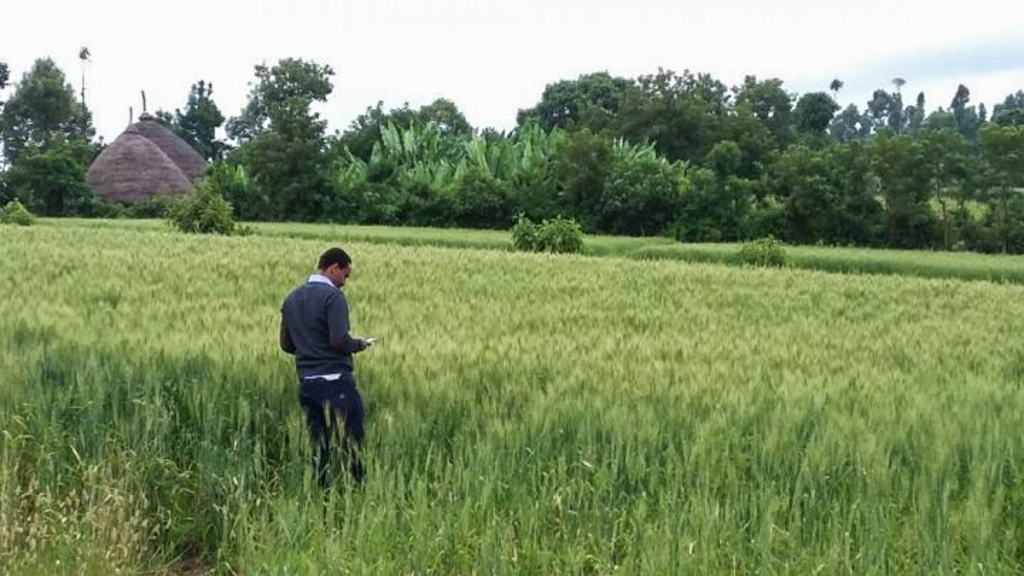13-Year Analysis Sheds New Light On Wheat Crop Disease Patterns In Ethiopia
Adapted from a news story on the website of the Borlaug Global Rust Initiative (BGRI)

A new study of wheat rust identifies previously unknown long-term trends and hotspots for wheat rust outbreaks in Ethiopia. A team of modelers from the University of Cambridge and the Universität Hamburg, along with surveillance experts from the International Maize and Wheat Improvement Center (CIMMYT), the Ethiopian Institute for Agricultural Research (EIAR) and agricultural universities in Ethiopia, announced their findings Feb. 3 in the open-access journal PLOS ONE.
Ethiopia is a major wheat producer, and millions of its households rely on the crop as a source of income or sustenance. Wheat rust poses a significant threat to wheat production; outbreaks can lead to crop failure and boost risk of famine. Today, crop surveillance data fuels an early warning system for wheat rust outbreaks in the country, but a comprehensive understanding of past outbreaks has been lacking.
“Long-term surveillance is essential for us to understand how important crop diseases, like wheat rusts, are changing over time,” said CIMMYT Senior Scientist and study co-author Dave Hodson. “We can then use that information to help improve farmers’ control strategies.”
To fill this gap, the study co-authors, led by Marcel Meyer of the Universität Hamburg, evaluated 13 years’ worth of surveillance data from more than 13,000 fields across Ethiopia. The scientists employed geographical analysis, statistical tools, and data-driven modeling to identify long-term, countrywide trends for the three types of wheat rust: stem, stripe, and leaf.
“Through the dedicated efforts of many partners, the study in Ethiopia has revealed new insights and highlighted the importance and continuing threat that these fungal diseases pose to wheat farmers,” said Hodson.
Recurrent outbreaks
The analysis showed that all three types of wheat rust have contributed to recurrent outbreaks over the past decade, causing estimated economic losses of tens of millions of U.S. dollars per year. Each type poses increased risk in distinct geographical hotspots, and the two most common types (stem and stripe) display distinct directional trends in their prevalence. All three types vary in prevalence according to altitude.
The researchers also found evidence for a “boom-and-bust” outbreak cycle that may result from widespread adaptation of specific wheat varieties bred for genetic resistance to certain subtypes of wheat rust, only for resistance to break down or other subtypes to infect the crops.
These findings could help improve wheat rust surveillance and control efforts, such as targeted application of fungicides and planting of certain rust-resistant wheat varieties in key geographical locations. The results could also aid development of mathematical models to accurately predict future outbreak patterns.
“Comprehensive annual field surveillance efforts combined with methods from data-science reveal patterns in large-scale epidemics of potentially devastating fungal diseases of staple crops of wheat in Ethiopia, the principal country for wheat production in sub-Saharan Africa,” said the authors. “The pattern revealed in the analyses for three wheat rust diseases underline the importance of sustained pest management for food security.”
Field surveillance efforts were funded by Borlaug Global Rust Initiative’s Durable Rust Resistance in Wheat (DRRW) and Delivering Genetic Gain in Wheat (DGGW) projects, funded by the Bill & Melinda Gates Foundation and the UK Foreign, Commonwealth and Development Office. DRRW and DGGW are predecessors of the Accelerating Genetic Gains in Maize and Wheat for Improved Livelihoods (AGG) project.




